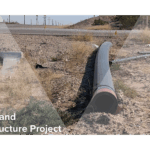
A Phase 1 Environmental Site Assessment (ESA) is an essential step in understanding the environmental risks associated with a property. In Midland, where industrial and commercial activities are prevalent, these assessments play a crucial role in ensuring the protection of both public health and the environment.
Understanding the Importance of Phase 1 Environmental Site Assessments
Environmental protection is of paramount importance in today’s society, and Phase 1 assessments form the foundation for achieving this goal. These assessments aim to identify any potential environmental hazards or contamination on a property before any further development or transactions take place. By conducting a thorough evaluation of a site’s history and current conditions, environmental professionals can assess the risks associated with it and provide recommendations for mitigating any potential issues.
The Role of Phase 1 Assessments in Environmental Protection
Phase 1 assessments act as an early warning system, allowing stakeholders to make informed decisions related to land use and development. By identifying potential hazards and contamination sources, these assessments help prevent the further spread of pollutants and ensure the protection of water resources, ecosystems, and human health.
Moreover, Phase 1 assessments are often required by lenders, real estate developers, and regulatory agencies before acquiring a property or initiating development projects. This requirement ensures that any environmental liabilities are identified and addressed, protecting the financial and legal interests of all parties involved.
Key Components of a Phase 1 Environmental Site Assessment
A Phase 1 ESA typically consists of several key components, each playing an integral role in the overall assessment process. These components include:
- Site inspection and data collection
- Historical review of the site
- Evaluation of potential environmental risks
The site inspection involves a detailed examination of the property, including its current conditions and any existing or potential pollutant sources. The data collected during this stage serves as the basis for further investigation and analysis.
The historical review is an essential component that involves researching the site’s history through records, interviews, and other available sources of information. This step helps identify past activities and uses that may have introduced contaminants to the site.
Evaluating potential environmental risks involves assessing the site’s proximity to known sources of contamination, such as industrial facilities, underground storage tanks, or waste disposal sites. It also considers the geology and hydrogeology of the area to determine the potential pathways for contaminant migration.
The Process of Conducting a Phase 1 Environmental Site Assessment in Midland
Conducting a Phase 1 ESA in Midland follows a standardized process that ensures the comprehensive evaluation of environmental risks. This process typically involves several stages, including:
Initial Site Inspection and Data Collection
The initial site inspection entails visiting the property to observe and document its physical characteristics. This includes recording the site’s topography, vegetation, property boundaries, and any potential pollutant sources. Data collection may also involve surveying neighboring properties and interviewing individuals familiar with the site’s history and activities.
During this stage, environmental professionals may collect samples, such as soil or groundwater, if any potential sources of contamination are identified. These samples are then analyzed in laboratories to determine their quality and potential impact on the site.
Historical Review of the Site
Performing a historical review is crucial for understanding past activities that may have affected the site’s environmental condition. This involves examining historical records, maps, aerial images, and conducting interviews with individuals who have knowledge of the site’s past use. By piecing together the site’s history, environmental professionals can identify potential contamination sources and focus their subsequent investigations accordingly.
Evaluation of Potential Environmental Risks
Assessing potential environmental risks involves considering the site’s current and past activities, as well as its surrounding environment. This evaluation includes identifying potential contaminant sources, analyzing the site’s geology and hydrogeology, and evaluating the potential pathways for contaminant migration.
Environmental professionals may also examine the site’s compliance with applicable federal, state, and local environmental regulations to identify any potential legal or financial liabilities associated with the property.
Regulatory Framework for Phase 1 Environmental Site Assessments
Phase 1 ESAs in Midland are conducted in accordance with a well-defined regulatory framework that ensures consistency and adherence to environmental protection standards. This framework includes:
Federal and State Environmental Laws
At the federal level, Phase 1 assessments must comply with the Comprehensive Environmental Response, Compensation, and Liability Act (CERCLA) and the Resource Conservation and Recovery Act (RCRA). These regulations establish the guidelines for assessing and managing potential environmental contamination.
State environmental laws also play a crucial role in governing Phase 1 assessments. In Midland, environmental professionals must adhere to the regulations set by the Texas Commission on Environmental Quality (TCEQ) and other relevant state agencies.
Compliance with Midland’s Local Environmental Regulations
In addition to federal and state regulations, Midland has its own set of local environmental regulations that govern site assessments and development projects. Environmental professionals conducting Phase 1 assessments in Midland must be familiar with these local regulations to ensure compliance and avoid any potential legal or regulatory complications.
Interpreting the Results of a Phase 1 Environmental Site Assessment
Interpreting the results of a Phase 1 ESA is a critical step in understanding the potential environmental risks associated with a property. The assessment report typically includes:
Identifying Recognized Environmental Conditions (RECs)
RECs are any potential sources of contamination or environmental liabilities identified during the assessment process. These could include past spills, underground storage tanks, or the presence of hazardous substances on the site. Environmental professionals evaluate these RECs to determine the significance of the potential risks and provide recommendations for further actions.
Recommendations and Next Steps After the Assessment
Based on the findings and identified RECs, environmental professionals provide recommendations for further actions and potential strategies for mitigating the environmental risks associated with the property. These recommendations may include additional investigations, monitoring programs, remediation plans, or further assessment stages, such as Phase 2 ESAs.
The Role of Environmental Professionals in Phase 1 Assessments
Environmental professionals, such as environmental consultants and engineers, play a vital role in conducting Phase 1 assessments effectively. These professionals possess the technical expertise and knowledge required to evaluate environmental risks and ensure compliance with regulatory standards.
Qualifications and Responsibilities of Environmental Professionals
Environmental professionals must have a solid understanding of relevant environmental regulations, site assessment techniques, and risk evaluation methodologies. They should possess advanced educational backgrounds in environmental science, engineering, or related fields, and often hold additional certifications or licenses.
These professionals are responsible for conducting thorough investigations, collecting and analyzing data, and interpreting the results to provide accurate and reliable assessments. They work closely with clients, regulatory authorities, and other stakeholders to ensure all necessary requirements are met and the assessment meets the intended purpose.
Selecting the Right Environmental Professional for Your Assessment
Choosing the right environmental professional is crucial for obtaining an accurate and reliable Phase 1 assessment. When selecting an environmental professional in Midland, consider their qualifications, experience, and track record of successfully completed assessments.
Additionally, consider the specific needs of your project or property. An environmental professional with expertise in the specific industry or type of property can provide valuable insights and tailor the assessment to meet your requirements effectively.
In conclusion, Phase 1 Environmental Site Assessments are an integral part of understanding and managing potential environmental risks associated with properties in Midland. By conducting thorough assessments in compliance with regulatory frameworks, stakeholders can make informed decisions, protect public health and the environment, and ensure the long-term sustainability of the city’s development.
Ready to take the next step in ensuring the environmental integrity of your property in Midland? ESE Partners is here to guide you through the complexities of Phase 1 Environmental Site Assessments with our team of dedicated environmental engineers and scientists. We understand the unique challenges and regulatory requirements your business may face. With our commitment to innovative and sustainable solutions, we’ll help you move forward responsibly while improving the community’s quality of life. Don’t wait to address potential environmental risks—Request A Proposal today and partner with a firm that delivers honest, quality-driven results.








